
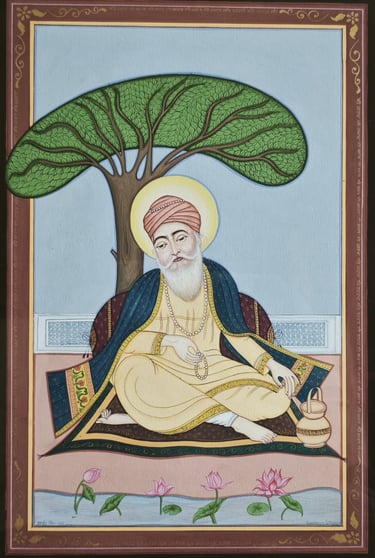
This hand-painted Sikh miniature artwork by Artist Gurpreet Singh Mankoo features Guru Nanak Dev Ji, the revered founder of Sikhism and the first of the ten Sikh Gurus. Seated peacefully beneath a sacred tree beside a lotus-filled pond, Guru Nanak is portrayed in his elder years, with a flowing grey beard, a calm, meditative expression, and a traditional turban. A subtle golden halo behind his head reflects his divine wisdom, while a rosary held gently in his right hand speaks to his deep spiritual practice. The serene blue sky in the background evokes a sense of infinity, and the rhythmic placement of lotus blooms adds balance and harmony to the composition. The painting is created using gouache—a rich, opaque watercolour—on high-quality acid-free paper, preserving both its color and detail over time.
Guru Nanak Dev Ji
Sikh Miniature painting emerged in the 18th century when Sikh rulers began commissioning Pahari artists—trained in Mughal and Rajput styles—to depict Sikh history and spiritual life. Influenced by the Kangra school, these works often featured floral and natural motifs. Artists used natural pigments on Wasli paper to illustrate scenes from the lives of the Gurus, historical events, and later, themes relevant to Sikh society.
Gurpreet Singh Mankoo, born in 1975 in Jagraon, Punjab, is a realist and miniature artist known for his religious and portrait works. Trained under Sardar Dilbagh Singh, he later founded the Mankoo Art Gallery. In 2013, he began restoring Mohrakashi murals at Shri Darbar Sahib and later at the UNESCO-listed Krishan Mandir. His work has been exhibited in India and abroad. He now focuses on miniature paintings in Kangra and Dakshini styles.






Sat kartar written in 24k gold
Fine and sharp lines
Precise & Fine details
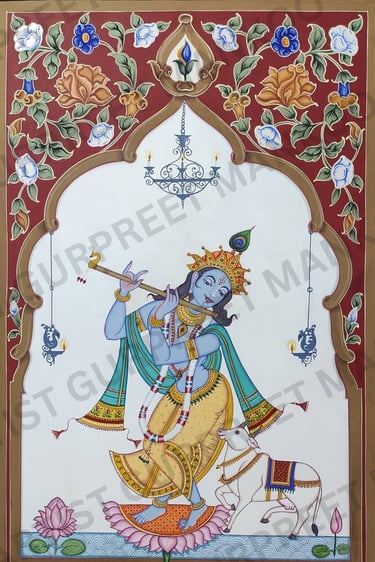

This Mohrakashi painting by Gurpreet Singh Mankoo features Lord Krishna playing the flute, standing on a lotus bloom beside his sacred cow. The intricate background is done in Naqashi—a traditional Mohraqashi technique where raw natural materials like lime and stone pigments are carefully treated and blended to create rich, harmonious patterns. Through months of preparation, these harsh elements are transformed into a unified, soulful composition. Krishna is shown in classic form: blue-skinned, clothed in yellow, radiating serenity.
Lord Krishna lost in music
Sikh Miniature painting emerged in the 18th century when Sikh rulers began commissioning Pahari artists—trained in Mughal and Rajput styles—to depict Sikh history and spiritual life. Influenced by the Kangra school, these works often featured floral and natural motifs. Artists used natural pigments on Wasli paper to illustrate scenes from the lives of the Gurus, historical events, and later, themes relevant to Sikh society.
Gurpreet Singh Mankoo, born in 1975 in Jagraon, Punjab, is a realist and miniature artist known for his religious and portrait works. Trained under Sardar Dilbagh Singh, he later founded the Mankoo Art Gallery. In 2013, he began restoring Mohrakashi murals at Shri Darbar Sahib and later at the UNESCO-listed Krishan Mandir. His work has been exhibited in India and abroad. He now focuses on miniature paintings in Kangra and Dakshini styles.


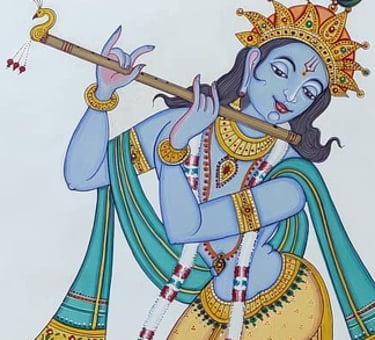



Traditional mohraqashi designs
24k gold used in jeweleries
Precise & Fine details
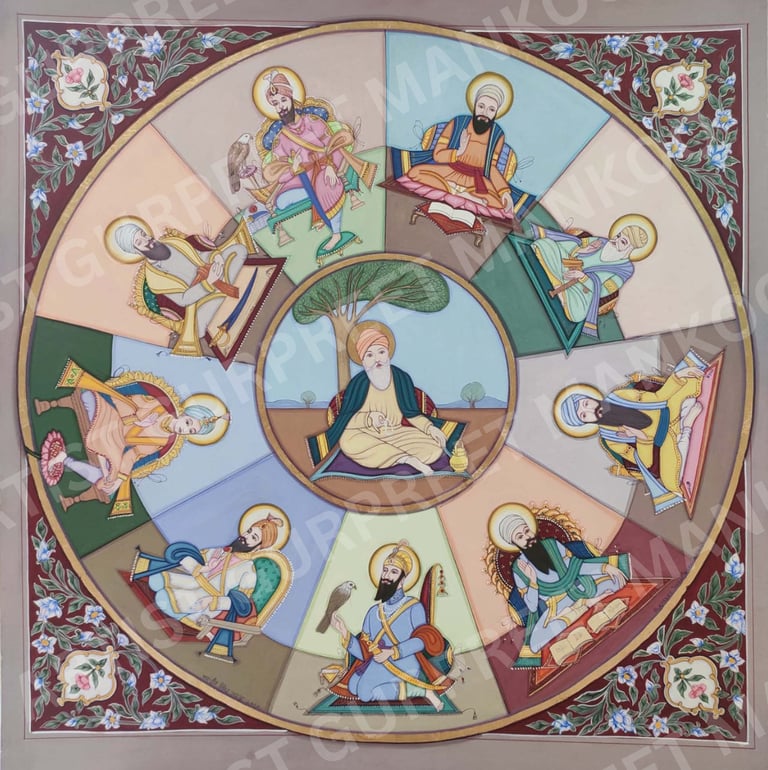

This Sikh miniature by Gurpreet Singh Mankoo portrays the ten Sikh Gurus in a circular arrangement, with Guru Nanak depicted at the center—shown as a serene elder holding a holy book and rosary. The surrounding panels feature the other Gurus in sequence, from Guru Angad to Guru Gobind Singh. Such collective depictions are a tradition in Sikh miniature art, symbolizing unity and continuity in Sikh history. The work is painted in gouache on acid-free paper, with gold foil highlights that reflect the spiritual radiance of the Gurus.
Das Gurus
Sikh Miniature painting emerged in the 18th century when Sikh rulers began commissioning Pahari artists—trained in Mughal and Rajput styles—to depict Sikh history and spiritual life. Influenced by the Kangra school, these works often featured floral and natural motifs. Artists used natural pigments on Wasli paper to illustrate scenes from the lives of the Gurus, historical events, and later, themes relevant to Sikh society.
Gurpreet Singh Mankoo, born in 1975 in Jagraon, Punjab, is a realist and miniature artist known for his religious and portrait works. Trained under Sardar Dilbagh Singh, he later founded the Mankoo Art Gallery. In 2013, he began restoring Mohrakashi murals at Shri Darbar Sahib and later at the UNESCO-listed Krishan Mandir. His work has been exhibited in India and abroad. He now focuses on miniature paintings in Kangra and Dakshini styles.
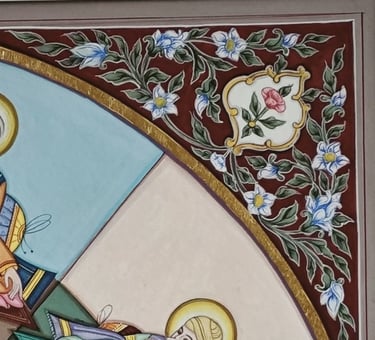

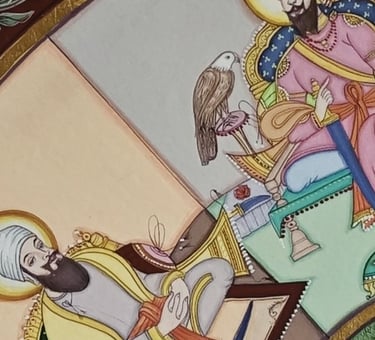

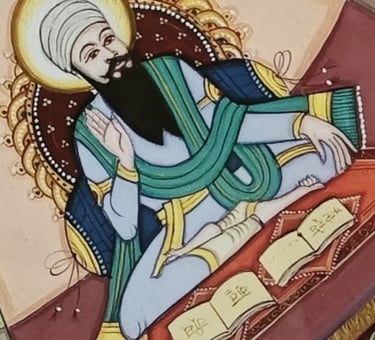

Traditional mohraqashi designs
24k gold used in jeweleries
Precise & Fine details

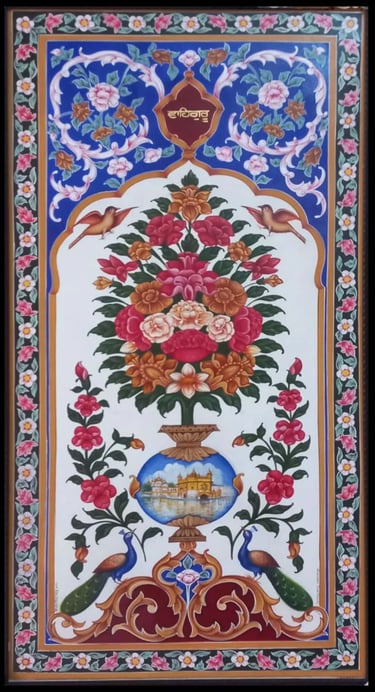
This Mohrakashi painting by Gurpreet Singh Mankoo showcases intricate Naqashi—a traditional technique where raw natural materials like lime and stone pigments are carefully processed and blended in their wet stage to create unified, ornate patterns. Once harsh in their raw form, these elements are transformed through months of preparation into a harmonious whole. Using natural stone pigments and gold foil on acid-free paper, the artist has rendered a rich design of floral and foliage motifs.
Mohrakashi Design
Mohrakashi is a traditional Punjabi fresco art that flourished in the 18th century, largely due to efforts by Maharaja Jassa Singh Ahluwalia and Sikh chieftains during the restoration of Darbar Sahib in Amritsar. This marked the rise of the Sikh school of art, known for its floral and foliage motifs inspired by the Kangra style. Made using stone pigments embedded into wet plaster, Mohrakashi murals are highly durable and adorn gurudwaras, temples, havelis, and heritage sites across Punjab and beyond.
Gurpreet Singh Mankoo, born in 1975 in Jagraon, Punjab, is a realist and miniature artist known for his religious and portrait works. Trained under Sardar Dilbagh Singh, he later founded the Mankoo Art Gallery. In 2013, he began restoring Mohrakashi murals at Shri Darbar Sahib and later at the UNESCO-listed Krishan Mandir. His work has been exhibited in India and abroad. He now focuses on miniature paintings in Kangra and Dakshini styles.
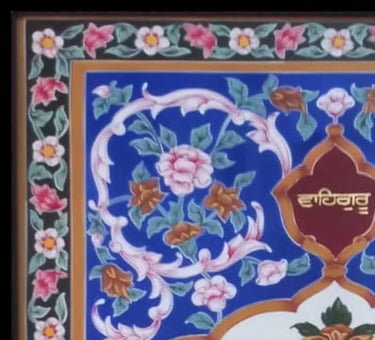

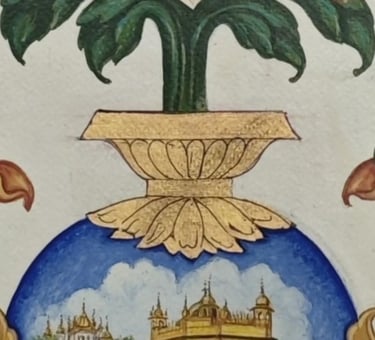



Traditional mohraqashi designs
24k gold
Precise & Fine details
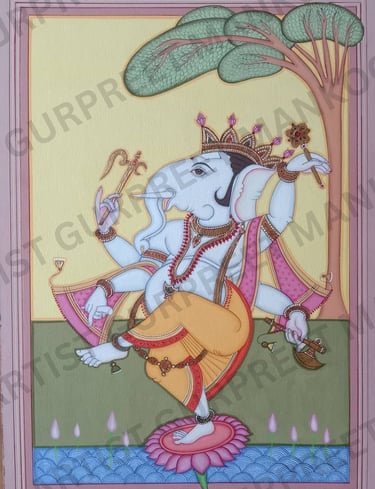

This hand-painted miniature by Gurpreet Singh Mankoo portrays Lord Ganesha with a one-tusked elephant head and pot belly, dancing gracefully on a lotus bloom. Set against a forest backdrop, the artwork follows the Sikh miniature tradition—rendered in a naturalistic style using opaque colors on acid-free paper.
Natya Ganesha
Sikh Miniature painting emerged in the 18th century when Sikh rulers began commissioning Pahari artists—trained in Mughal and Rajput styles—to depict Sikh history and spiritual life. Influenced by the Kangra school, these works often featured floral and natural motifs. Artists used natural pigments on Wasli paper to illustrate scenes from the lives of the Gurus, historical events, and later, themes relevant to Sikh society.
Gurpreet Singh Mankoo, born in 1975 in Jagraon, Punjab, is a realist and miniature artist known for his religious and portrait works. Trained under Sardar Dilbagh Singh, he later founded the Mankoo Art Gallery. In 2013, he began restoring Mohrakashi murals at Shri Darbar Sahib and later at the UNESCO-listed Krishan Mandir. His work has been exhibited in India and abroad. He now focuses on miniature paintings in Kangra and Dakshini styles.
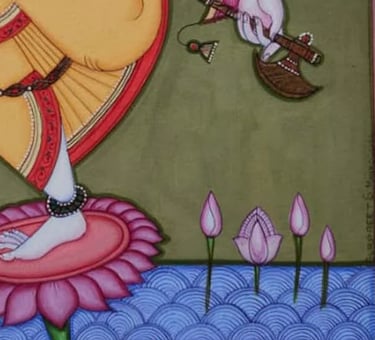





Precise & Fine lines
24k gold used in jeweleries
Deep details
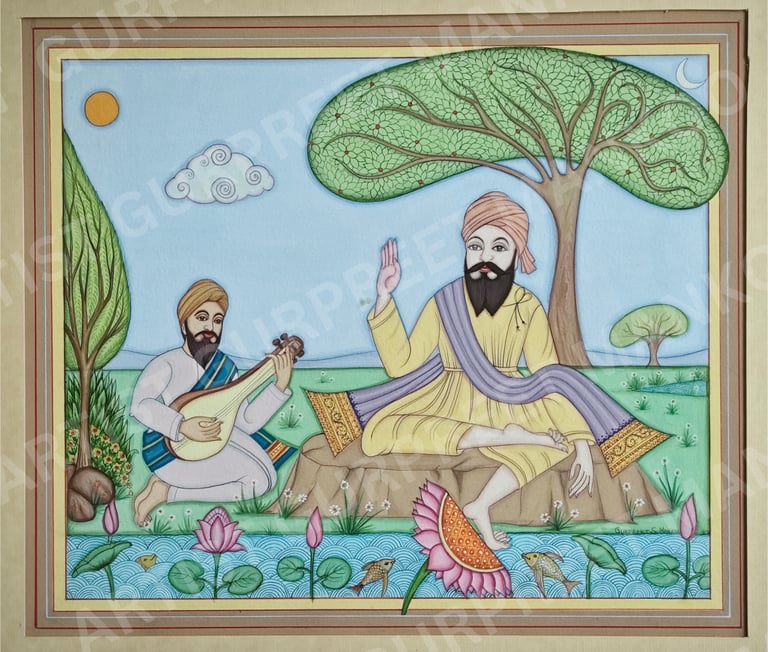

This painting by Gurpreet S. Mankoo portrays Guru Nanak Dev Ji seated peacefully beneath a large tree, with Bhai Mardana Ji playing the rabab beside him. Set in a natural landscape of flowing water, lotus flowers, and birds, the scene reflects deep serenity and spiritual harmony. Guru Nanak’s calm gaze and raised hand in blessing symbolise divine wisdom and compassion. Painted in the Sikh miniature style, the artwork uses soft colours and intricate details to capture a timeless moment of devotion, music, and connection with nature.
Guru Nanak with Bhai Mardana
Sikh Miniature painting emerged in the 18th century when Sikh rulers began commissioning Pahari artists—trained in Mughal and Rajput styles—to depict Sikh history and spiritual life. Influenced by the Kangra school, these works often featured floral and natural motifs. Artists used natural pigments on Wasli paper to illustrate scenes from the lives of the Gurus, historical events, and later, themes relevant to Sikh society.
Gurpreet Singh Mankoo, born in 1975 in Jagraon, Punjab, is a realist and miniature artist known for his religious and portrait works. Trained under Sardar Dilbagh Singh, he later founded the Mankoo Art Gallery. In 2013, he began restoring Mohrakashi murals at Shri Darbar Sahib and later at the UNESCO-listed Krishan Mandir. His work has been exhibited in India and abroad. He now focuses on miniature paintings in Kangra and Dakshini styles.
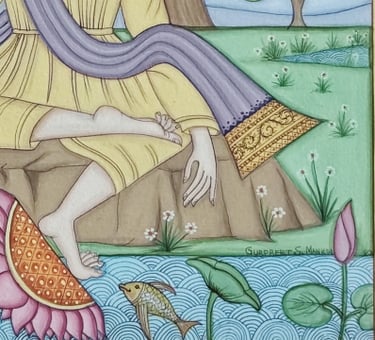





Precise & Fine lines
24k gold used in shall
Representig mardana ji playing rabab
Artist Gurpreet Mankoo
Celebrating the art of mohrakashi revival.
Artistry
Want to buy some art pieces
© 2025. All rights reserved.